2008 Kawasaki Teryx 750
2008 KAWASAKI TERYX™ 750 4×4 Review
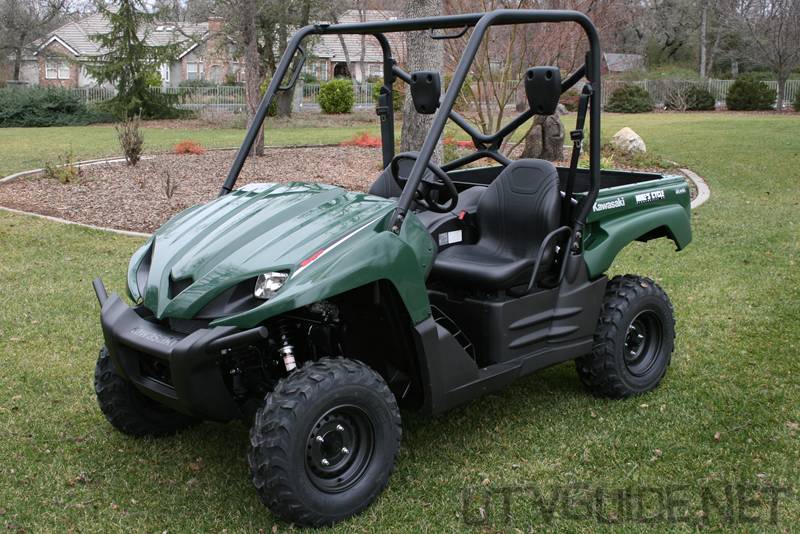
2008 Kawasaki Teryx 750 4×4 – Teryx
2009 Kawasaki Teryx Sport EFI Review
First Ride Impressions:
-
Looks A LOT like a Rhino from a distance. Did not feel any bigger than a Rhino.
-
It is HEAVY. Curb weight is 614 kg which is 1350 lbs – Dry weight is 1276 lbs. (more than 200 lbs. heavier than a Rhino). The frame looks more stout that a Rhino or RZR, and I am sure the v-twin is a heavy engine.
-
It did not feel that fast. About like a 700 Rhino by my seat of the pants dyno on asphalt/dirt.
-
Exhaust is very quiet. The outlet looks very small, so I am thinking that power will greatly benefit from aftermarket pipe. The header from the front cylinder is much longer than the other.
-
Intake is right by your elbow and opens at the bed. Looks pretty restricted, but nice and high for wet conditions.
-
The 2008 Teryx is carbureted. 2009 Teryx is fuel injected.
-
Hood does not open without using screwdriver.
-
Access to engine is a pain. Lots of push pins and screws.
-
Standard model has no tilt bed and no digital dash (speedo, odo, etc). LE model has tilt bed and digital dash.
-
Piggyback reservoir shocks in the rear, but not in the front. The ride is very nice, but I would have liked to see reservoirs all the way around.
-
Rear differential support looks excellent.
-
Frame, a-arm mounts, shock mounts and a-arms all look very solid. This will be a nice platform to build a race UTV or just to take general abuse.
-
Surprised Kawasaki didn't go with doors after all the issues Yamaha is dealing with.
-
Top speed is 48mph.
-
No fuel gauge on standard model. 2009 Teryx has a fuel gauge.
-
Video of Teryx vs. RZR drag on pavement – The Teryx is definitely slower than a Polaris RZR. There are reports that a 2008 Rhino 700 just barely beat the Teryx too. Hunterworks.com put a Teryx the dyno, and got 27.63 HP to the wheels. In comparison, a Rhino 660 put down 25 HP. With the extra weight, it is easy to see why the Teryx could lose a drag race with a Rhino 700.
-
The Teryx has their timing retarded a bit more for under 12 mph so it is not as fast off the line as it could be. Aftermarket CDIs will surely address this.
-
If you are looking for the fastest UTV, and don't want to do any sort of modifications, the Teryx is not your side x side. With the extra weight and the choked back engine/exhaust/intake, the stock Teryx is about on par with a stock Rhino 660. The v-twin does hold a lot of promise for modifications and is probably the best engine of any currently available UTV to build up.
-
The good news for those looking for more power is I think it will be generally easy to come by. I think there will be large gains with a CDI, Exhaust and Jetting.
Latest Teryx News:
-
2008 Teryx's are now showing up at dealers – January 18, 2008
-
2009 Teryx will have fuel gauge and EFI.
Size Comparison:
The Teryx is even bigger than a Rhino.
-
Kawasaki Teryx is 4″ wider than a Yamaha Rhino and 8″ wider than a Polaris RZR.
-
Kawasaki Teryx is 2″ longer that a Yamaha Rhino and 13″ longer that a Polaris RZR
-
Wheelbase is about the same as the Rhino and just a bit shorter than the RZR
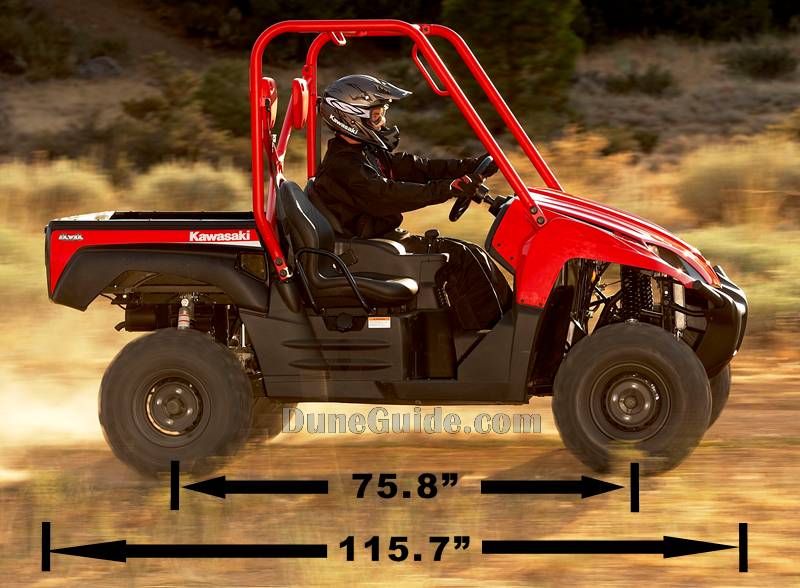
The Teryx has the same wheelbase as a Rhino, but it is 2″ longer
Even though the Teryx is wider, it still has the same amount of wheel travel as the Rhino – 7.3″.
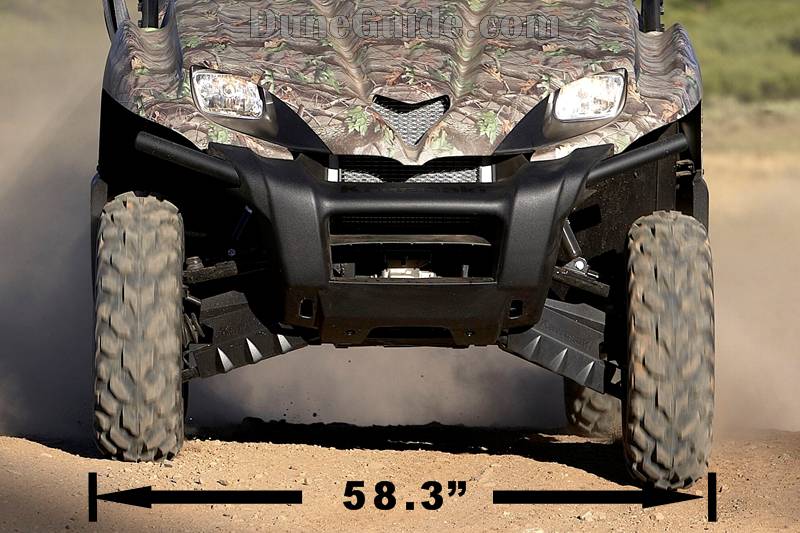
The Teryx is 4″ wider than a Rhino.
Curb Weight & Stock Horsepower:

614 kg or 1350 lbs. (wet). Kawasaki lists dry weight at 1276.1 lbs. That is more than 200 lbs. heavier than a Rhino!
33 kw converts to about 44 HP.
Torque is 41.5 ft/lb.
Engine:
The Teryx is powered by an updated version of Kawasaki's 749cc V-twin engine that's been proven in the Brute Force® 750 4X4i ATV. The Brute Force® reportedly has 51 HP in stock form. So the 44 HP that the Teryx has is a step down. It is unfortunate that Kawasaki did not opt for fuel injection like the new Brute Force has, but that will come in 2009.
There are reports that the v-twin can put down some serious horsepower in modified form. But from what I felt in stock form, it just didn't have the power I was expecting. If you are looking to keep your Teryx stock and have top performance, the Teryx is not it. Hopefully the aftermarket can make it fly.
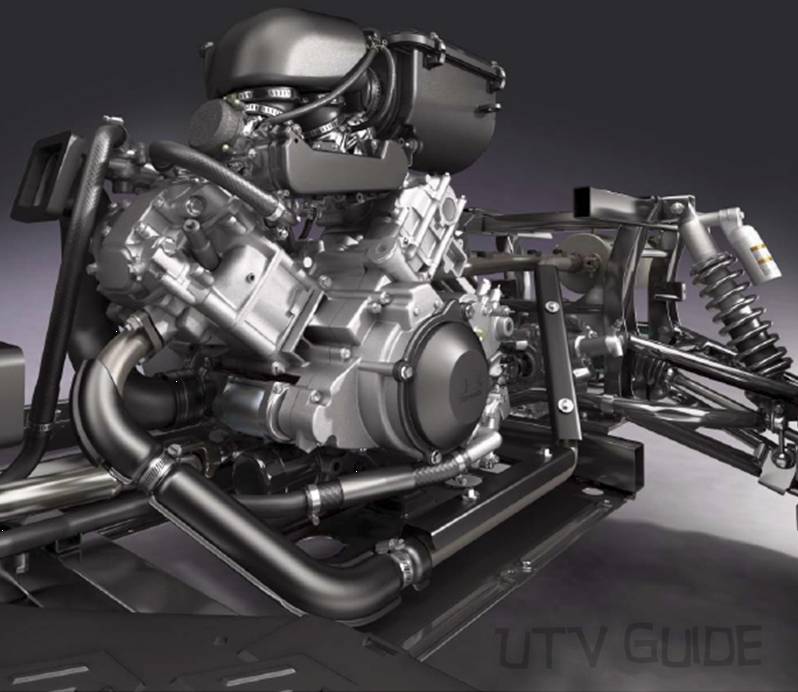
This may be a pre-production image of the engine
At the core of the Teryx 750 4×4 is its strong and proven 749cc 90-degree V-twin engine, the same engine that gives the Brute Force® 750 4×4 its distinguished high performance. The mid-chassis mounted engine gives the Teryx 750 4×4 a displacement and V-twin torque advantage over its contemporaries and delivers the performance that RSV customers have been seeking. Mated to the engine is Kawasaki's superb constant velocity automatic transmission (CVT), which transfers the power from the big V-twin to the wheels smoothly and quickly. The output of the duo provides a true sport performance, yet in a controlled manner that allows the driver to harness the full potential of the Teryx 750 4×4.
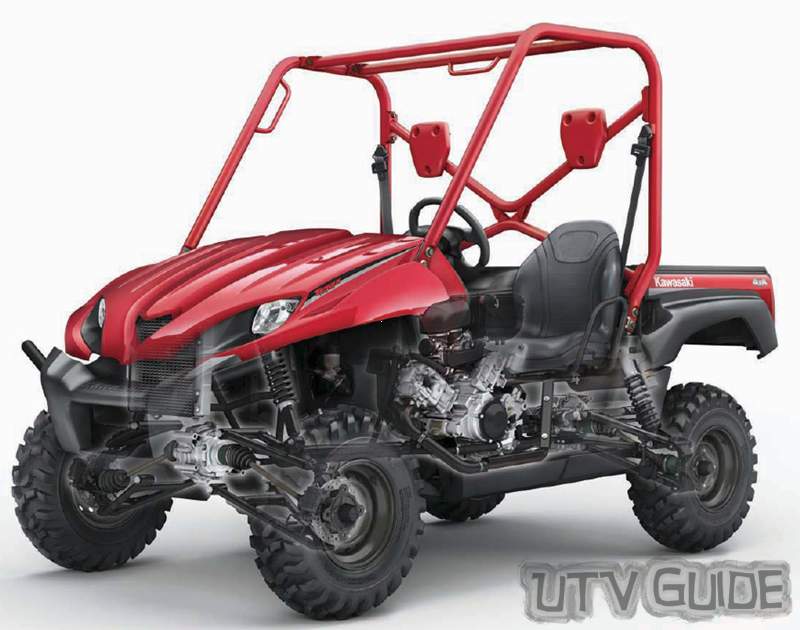
The fuel mixture reaches those ports through dual carburetors recalibrated specifically for the RUV application and which breathe through a larger capacity airbox designed to reduce intake noise. A new exhaust system is designed to broaden the powerband, while a new high-efficiency radiator helps keep the engine running at consistent temperatures.
Transmission:
Kawasaki Automatic Powerdrive System (KAPS) continuously variable transmission is re-tuned for hard-acceleration shifting, and the cover is now aluminum which acts as a heat sink for improved CVT cooling. The revised engine/CVT combination delivers instant acceleration at any rpm through beefier drive shafts and CV joints. To minimize unnecessary belt wear, the KAPS transmission is equipped with a brand-new system that helps prevent belt slippage if the vehicle becomes stuck. Using input from a gear sensor, vehicle speed measured at the rear wheels and engine rpm, the system automatically reduces engine speed if the engine operates at high rpm for more than two seconds while the rear wheels remain motionless. The engine is held under 3,000 rpm for approximately five seconds before it can rev freely again, but if the rear wheels still don't move after two seconds the system is activated once again. This gives drivers the opportunity to stop the engine and seek assistance before burning the belt.
There is no "park" selector on the transmission.
Chassis:
Naturally, big power demands a wide-bodychassis to compliment it and once again the Teryx delivers with an ideal width body – narrow enough to be useful and able to navigate the trail but wide enough to be stable and handle the healthy output from the V-twin. The engine is placed mid-chassis for better weight distribution. Its large-diameter, thin-walled tubular frame offers the necessary rigidity without performance draining weight, and all in an arrangement spacious enough to fit two adults comfortably.
The Teryx 750 4×4 shares the long A-arm and narrow frame concept of its sport brethren to give it the maximum travel while minimizing wheel camber change. Featuring adjustable Kayaba suspension with gas-charged shocks, the sport-performance focused suspension of the Teryx 750 4×4 is designed to remain controlled even at top speed.
The wide-track frame is based on the same long A-arm concept found on Kawasaki's sport ATV models, where the frame is made as narrow as possible so that long A-arms can be used. This configuration minimizes camber change as the long travel suspension tracks over rugged terrain for better performance.
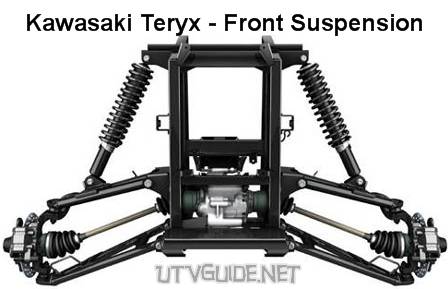
Narrow frame allows for longer a-arms with better geometry
Teryx:
Front upper:
A-Arm mount points are 16 3/4″ apart – A-Arms are 12 ½" Long
Front lower:
A-Arm mount points are 14 1/2″ apart – A-Arms are 16 ½" Long
Rear upper:
A-Arm mount points are 15 1/2″ apart – A-Arms are 15 ¾" Long
Rear bottom:
A-Arm mount points are 15″ apart – A-Arms are 14 ½" Long
Rhino:
Front upper:
A-Arm mount points are 17 1/4″ apart – A-Arms are 10 ¼" Long
Front lower:
A-Arm mount points are 17 1/2″ apart – A-Arms are 12 ¼" Long
Rear upper:
A-Arm mount points are 16 1/2″ apart – A-Arms are 12" Long
Rear bottom:
A-Arm mount points are 15″ apart – A-Arms are 13" Long



Here is an example of what is being measured. This is a picture of the rear of the Teryx. The upper A-Arm mounting locations are 15 1/2″ apart.





The frame, suspension mounts and a-arms look very solid. Looks like a great platform to build a race vehicle or even a sturdy long travel.
Rear differential mounting points look very good.
Seat Height:
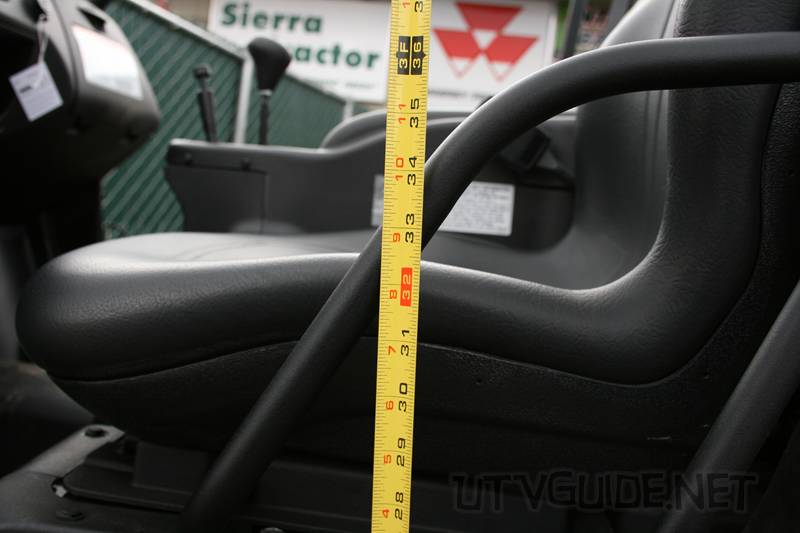
The seats in the Teryx sit right about 32″ above the ground. Higher than a Rhino by 2.5″, but lower than a Prowler and Ranger.
Roll Cage:
The integral cab frame meets SAE regulations as a Roll Over Protective Structure (ROPS).
Traction Control:
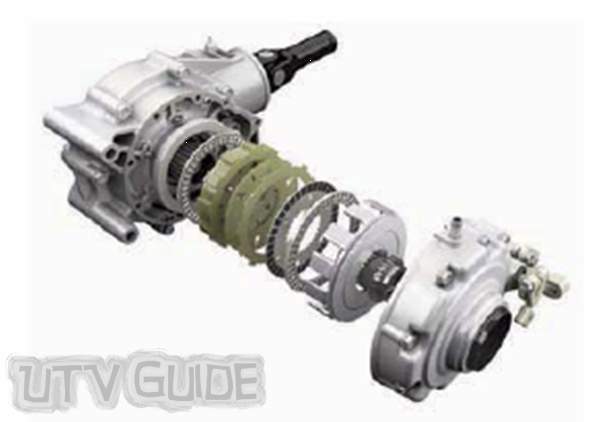
Kawasaki's Variable Front Differential Control allows the driver to control the amount of slip in the front differential when in four-wheel drive.
When the terrain requires it, the driver can activate 4WD with a simple servo-control switch. Further traction management is achieved via an ATV-style front differential control activated with a hand lever that functions like a rear hand brake and lets the driver select how much the wheels are locked together. The rear wheels stay locked and always turn together — much like a sport ATV — allowing the Teryx to slide around corners easier in a drift style.
The electrically selectable drive system utilizes an all new electrical/vacuum activated shift system so the operator can easily shift between two- and fourwheel drive, and the variable front differential control that allows the driver to fine-tune the amount of slip in the front differential. Without using the hand lever on the center console the system functions as a limited-slip differential, but when force is applied to the continuously variable lever torque is increased up to a maximum level equivalent to that of a mechanical differential lock when the system is fully engaged.
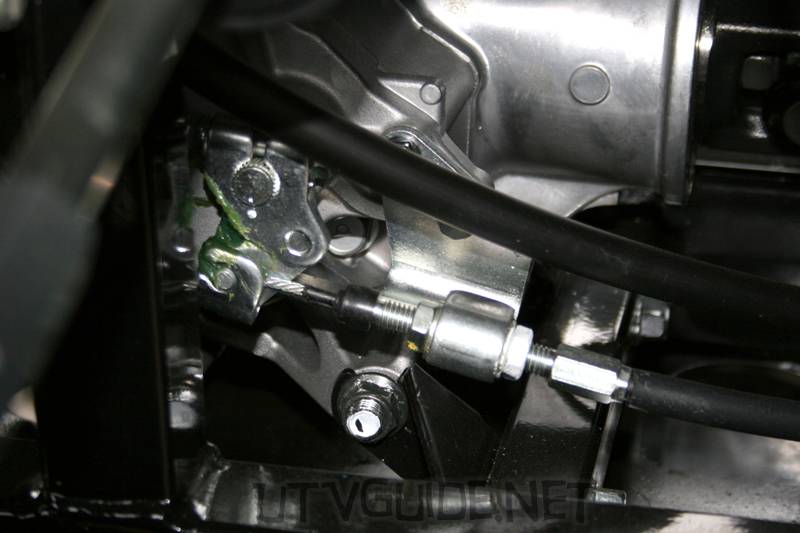
It continues its dominance in the field with new 26-inch Maxxis tires developed specifically for the Teryx 750 4×4 that enable superb forward and sliding traction. The tall tires offer good rough terrain handling and contribute to its class leading ground clearance and ability to overcome obstacles.
Braking:
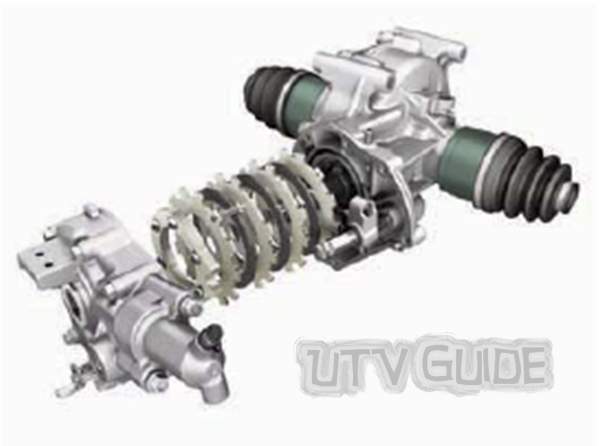
The unique sealed wet rear brake keeps the brake components out of the elements and provides exceptional braking performance.
A fast RSV would not be good without having equally capable stopping power and Teryx 750 4×4 delivers. It employs a combination of dual 200mm discs up front and a sealed wet brake in the rear. The front brakes are tucked into the wheels for protection from debris and their 27mm twin-piston calipers are rigid-mounted for optimum feel and control. The advantage of the sealed rear brake is most apparent when it's able to keep working even in the wettest or muddiest of environments.
The sealed wet rear brake has been proven on Kawasaki's ATV models, and gets an extra internal disc to provide extra stopping power for the Teryx.
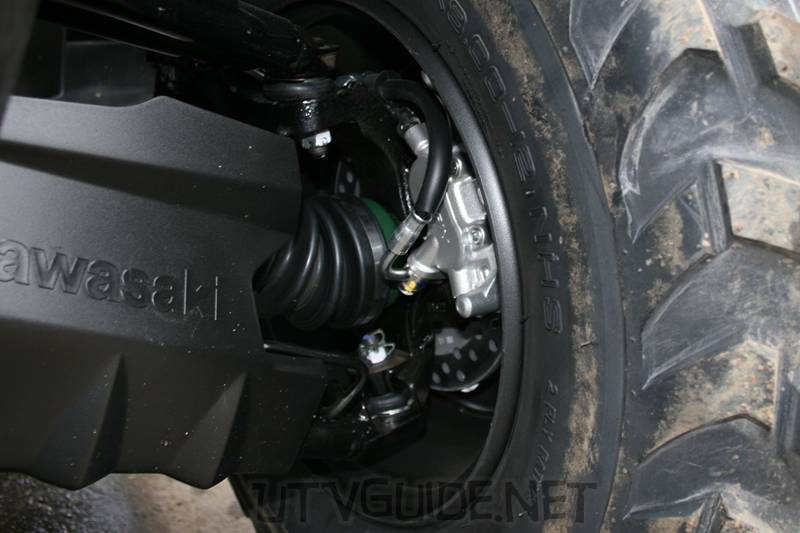
Front disk brakes
Ergonomics:
Featuring bucket seats and retractable three-point seat belts that keep the driver and passenger strapped in snugly, the Teryx 750 4×4 also has plenty of shoulder and leg room to provide a comfortable ride. It also has foot guards designed into the steel floor boards and body along with a padded steering wheel that is positioned low for better control.
Rider comfort and conveniences increase even more on the Teryx 750 4×4 LE, with the addition of a digital meter with dual trip meters, clock and hour-meter, half-windshield, hard top and dual retractable cup holders. The LE also features a tilting cargo bed with gas assist, which gives the tilting bed a boost.
The Teryx is comfortable for me at 6′ 1″.
Cargo:
The Teryx 750 4×4 isn't all play and no work. It is equipped with a 500-pound capacity cargo bed that is ideal for recreational users, yet versatile enough for work and hauling with tie down hooks in all four corners and comes with a cargo net to keep the goods secure. The Teryx 750 4×4 can also pull the load with its 1300-pound towing capacity.

Bed comes with a nice cargo net. The standard model does not have a tilt bed.


The hitch looks pretty beefy, although I don't really like how it hangs out past the frame.
Skid Plate:
Plastic skid plate is very wimpy., but it looks like there is enough clearance to protect everything.
More Photos:







Coolant Level Site Gauge (near passenger feet).

Large Glove Box




Rear shock has piggyback reservoir, Front shock does not. Ride quality is good for a stock UTV.


Rear differential support looks very solid – 4 mounting points up top and two on the bottom

Decent sized radiator with good air flow. Did not see an engine oil cooler. The radiator looks like it could use a bit more protection against debris.

Small "Leg Minders"

Parking brake is foot activated, and hand released. I don't really like the release mechanism.

Transmission does not have a "Park" selection. Front locker is actuated lick a clutch with the stick next to the gear selector. Locker can be used (locked/unlocked) while vehicle is in motion.



Standard dash – no speedometer or odometer. LE model has digital dash. If you want to add the digital dash to a standard version, the info is:
Digital multifunction meter = part # 999940110…….price $219.95.


Fuel tank under passenger seat


Battery, Fuses, CDI and idle adjustment are under driver's seat. Not sure I really like the wires, fuses and relays in an area that could easily get wet.










Airbox – The airbox lid looks very restrictive. But very easy to modify for more airflow. Unfortunately, the CV Carbs will need to be modified to allow for more air.










Exhaust looks very restrictive. It is very quiet. Stock silencer is 14 lbs 5.6 oz.

Wheel bolt pattern is 4/137 – 12mm studs.

Engine mounts look very sturdy and nicely positioned.

Winch plate behind front bumper

Cup Holders – Available on LE Models

The Tail Lights look like something you would pick out at Kragen's.


Clutch – CVT

Tilt Bed is available on LE Models – Bed weighs 104 lbs.












Teryx clutch pictures from UTVCrap.com
Photos on TexasQuads.org
Some comparison's between the Teryx and the Brute Force:
-
Teryx comes with 135 front and 140 rear main jets. The 2007 Brute Force came with 152 front and 158 rear. Pilot jet is the same.
-
Transmission gearing has been lowered.
-
Head pipe diameter is decreased to 29.4MM.
-
Cooling system increased to 3.28 quarts.
-
Exhaust volume muffler.
-
Cooling fins widened for more cooling.
-
Belt protection system reduced rpm in case of slippage.
-
Larger air-box volume.
-
Timing is advanced less on the Teryx.
Features:
At a glance
– First in class with a V-twin
– Sport performance with gas-charged rear shocks with reservoirs
– 26-inch Maxxis tires
– Sealed rear wet brake
– Ample 500-pound capacity cargo bed
Engine
– The 90-degree 749cc V-twin engine is the largest, most powerful engine in its class
– Positioned mid-ship for optimum front/rear balance – good for power slides and cornering control
– Straight intake tracts and 34mm downdraft carburetors enhance power delivery throughout the rpm range
– Radiator is compact and placed high in the chassis for better protection against mud and debris
– Ducts located by the cargo bed direct cooling air to the engine
– Aluminum cylinders are Electrofusion-plated for light weight, long wear and excellent heat dispersion
– Engine can be started in any gear when the rear brake is applied. Can be started in neutral without depressing brake.
– Electronically controlled Kawasaki Engine Brake Control helps to slow the RSV when traversing steep down hills
Transmission/Selectable Four-wheel-drive
– CVT features high and low ranges, plus reverse
– Combined with the engine power characteristics, provides instantaneous acceleration
– Rider can select two- or four-wheel-drive operation by pressing a button located on the dash
– Limited-slip front differential reduces steering effort under normal four-wheel drive operation, while Variable Front Differential Control permits rider to distribute torque equally to left and right front wheels for maximum traction via a hand lever
– Rear wheels are locked and always turning together for cornering control
Chassis
– Large-diameter thin-walled tubular steel frame
– Only RSV with integrated occupant protection
– First with sport performance-focused suspension – low-speed comfort not a main design priority
– Wide track provides excellent stability and chassis has 11.2 inches of ground clearance
– Long dual front A-arm suspension and narrow frame concept provides 7.5 inches of travel and features adjustable gas-charged Kayaba shocks
– Independent rear suspension provides the best balance of rider comfort and handling at high speeds, and adjustable gas-charged Kayaba shocks with reservoirs provides 7.25 inches of travel
– Chassis offers the right balance of bump absorption while limiting understeer
– Able to tackle corners in either a drift or grip style and operate beyond the limits of its rivals
Brakes
– Dual front 200mm disc brakes with two-piston 27mm calipers and Kawasaki's sealed, oil-bathed, multi-disc rear brake system provide maximum stopping power in all conditions
– Front discs are recessed in wheels for protection from debris
Tires/Wheels
– Good rough terrain performance and obstacle clearance with 26-inch Maxxis tires specially built for the Teryx 750 4×4
– Tread design enables both controlled sliding and forward traction
Bodywork/Ergonomics
– Bucket seats with retractable three-point seat belts
– Foot guards designed into the floor and body
– Padded steering wheel positioned low for better control
– Body work is made of high-gloss scratch resistant Thermo-Plastic Olefin
– Steel floor boards and engine guards for maximum protection
– Dual 40W headlights and dual taillights
– Cargo bed has 500 lb capacity, tie down hooks in all four corners and cargo net standard
TERYX 750 4×4 LE additional features
– Digital Meter
– Dual retractable cup holders
– Hard top
– Half-Windshield
– Tilting cargo bed with gas assist
2009 Kawasaki Teryx:


New Digital Fuel Injection system
- High output 750cc twin engine now has digital fuel injection, which enhances throttle response and automatically adjusts for changes in temperature and altitude
- The fuel injection system (controlled by a 32-bit CPU) continually monitors coolant temperature, air intake temperature, throttle position, air intake pressure, vehicle speed and crankshaft angle to automatically meter out the ideal amount of fuel via two 34mm throttle bodies for extremely stable power delivery – regardless of the conditions
- Instantaneous fuel delivery from the fuel injection makes its response sharper than ever
- FI systems permits easy engine starting at low temperature and utilizes an Automatic Idle Speed Control and Automatic Fast Idle function to ensure a smooth engine warm up
- The high-pressure fuel pump located inside the tank features a unique reservoir chamber at the bottom of the fuel pump to ensure air does not get into the fuel system
- Specific Teryx-sized throttle bodies and revised ignition timing have increased low and mid-range torque as well as improved response at higher rpm
- Revised ignition timing when in reverse combined with low-speed operation and deceleration FI settings better enable the engine to deal with increased moisture when driving in shallow water
Improved Continuously Variable Transmission
- Featuring high and low ranges, plus reverse, the CVT provides a very direct feel from the engine, and instantaneous acceleration – ideal characteristics for sport riding
- Transmission utilizes a high-grade belt that's highly durable and designed to handle the high output of the engine
- The CVT Belt Protection System better prevents tire freewheel, has upgraded rock section performance and less belt overloading by adding Throttle Position Sensor (TPS) data into the system
- For better protection against water entry, the intake and exhaust ducts were changed, with the new exhaust duct opening located higher and the revised intake duct flowing more air to the CVT for better cooling
- Intake temperature reduced with heat shielding on the exhaust pipe below the intake duct
New Airbox design
- Increasing air cleaner box volume and changing the ducting shape and length lowered the noise level near riders' heads
Links:
- Kawasaki Teryx – Overview and Specifications (2010 – 2012)
- 2009 Kawasaki Teryx Review
- 2010 Kawasaki Teryx Review
- Kawasaki Teryx Buildup Project
- Aftermarket Teryx Roll Cages, Bumpers and Doors
- Teryx Long Travel Kits
- Teryx Roll Cages
- Teryx Performance Parts
- UTV Comparison
Kawasaki Website Links:
- Kawasaki Teryx News Release
- Kawasaki Teryx 750 Features & Spec
- Kawasaki Teryx 750 4×4
- Kawasaki Teryx 750 4×4 LE
- Kawasaki Teryx 750 4×4 NRA Outdoors
- 2008 KAWASAKI TERYX™ 750 4×4 / TERYX™ 750 4×4 LE – Kawasaki News
Teryx Videos:
- Teryx 750 4×4 Product Showcase – KawasakiLive.com
- Teryx 750 4×4 NRA OUTDOORS Product Showcase – KawasakiLive.com
- Teryx 750 4×4 LE Product Showcase – KawasakiLive.com
- Teryx Video Commercial – Pretty funny
- ATV TV Teaser Teryx Video – QuickTime format
- ATV Television Test – 2008 Kawasaki Teryx 750 Part 1
- ATV Television Test – 2008 Kawasaki Teryx 750 Part 2
- Video of Teryx vs. RZR drag race on pavement
- Teryx vs. Rhino 700EFI drag race – YouTube
- Teryx Lineup Video – UtilityOffroad.com
- Teryx through a "Whoops" section – UtilityOffroad.com
- Kawasaki Teryx Video – Two short runs
- Yamaha Rhino 660 vs. Kawasaki Teryx -Short Drag Race
- RZR vs. Prowler vs. Teryx vs. Modified Rhino Drag Race
- RZR vs. Teryx with CDI Drag Race
Source: https://www.utvguide.net/kawasaki_teryx_review/







Tidak ada komentar:
Posting Komentar